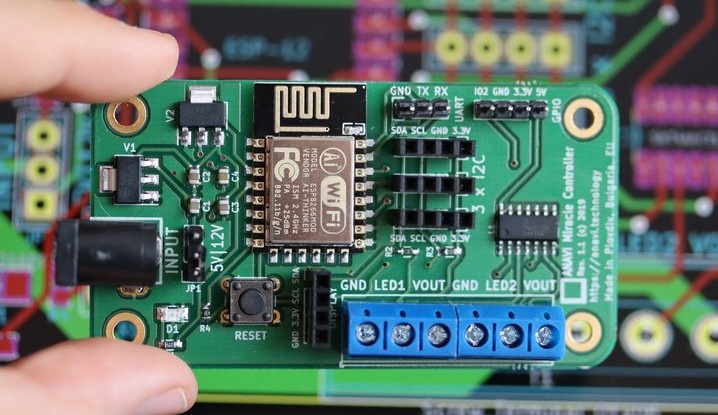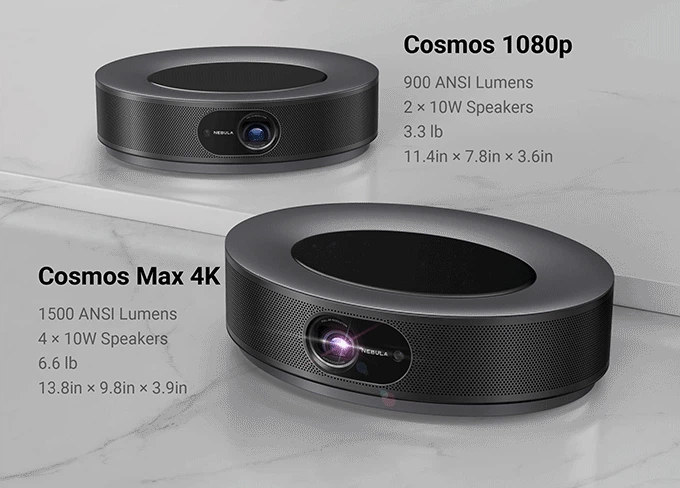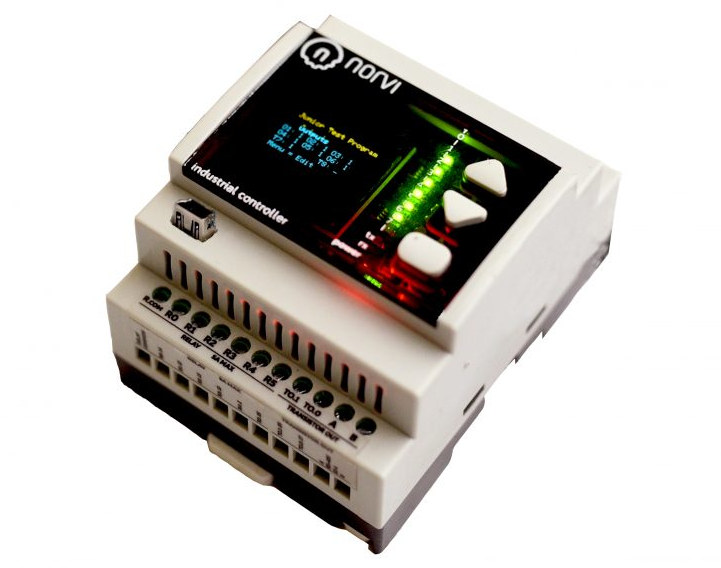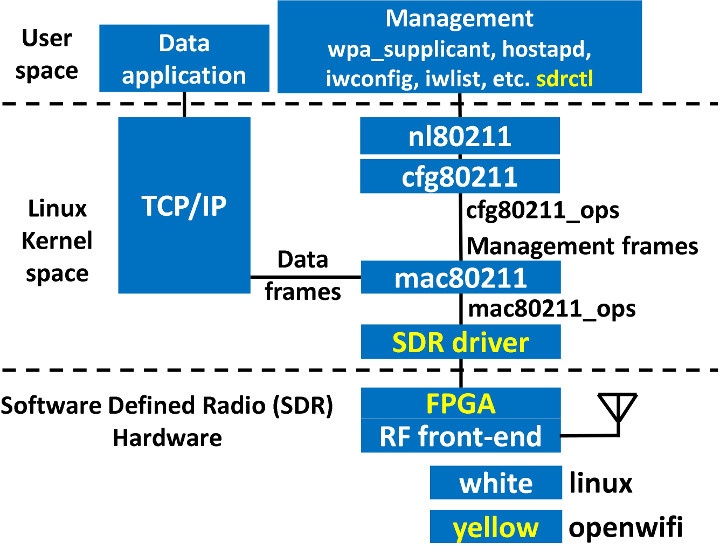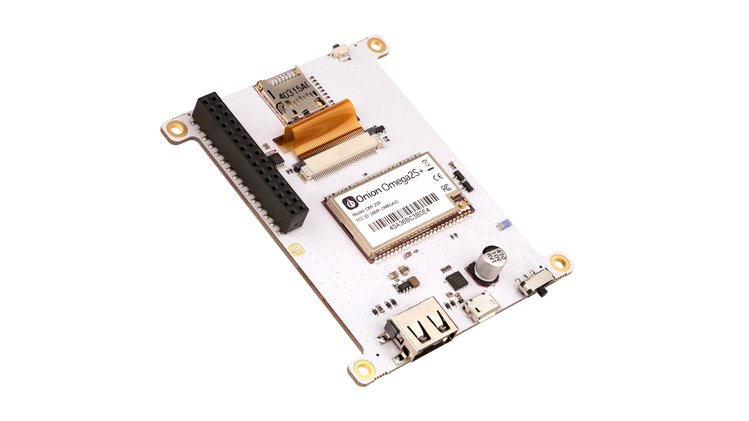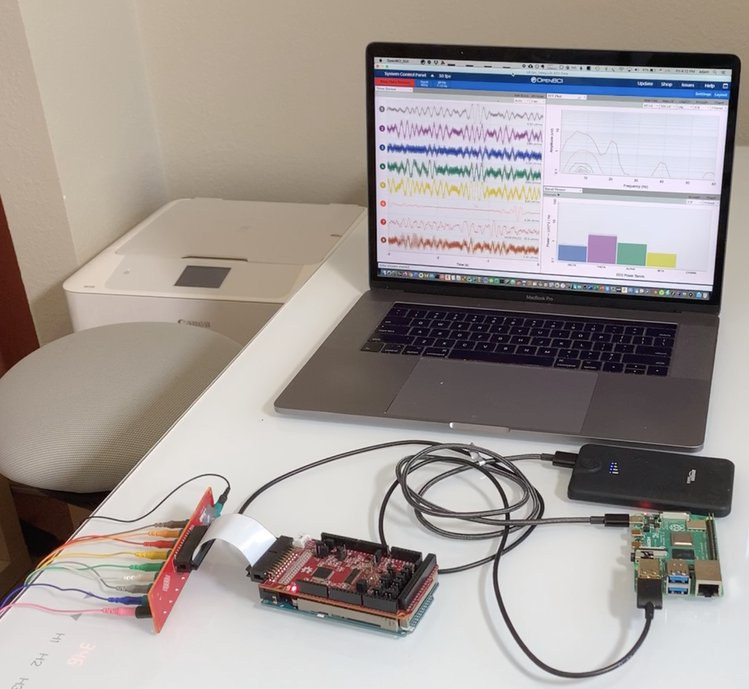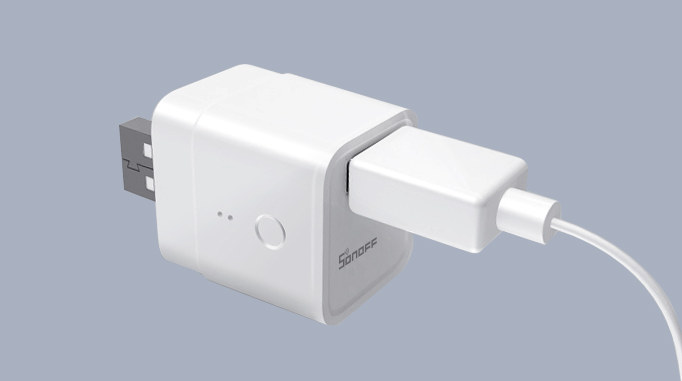Last year, we wrote a tutorial showing how to control an RGB LED strip Control ANAVI Light ESP8266 controller. The board only works with standard non-addressable 12V LED strips however, and Leon ANAVI received requests to support 5V and 12V addressable LED strips such as NeoPixels, WS2811, WS2812, or TM1804. So he updated ANAVI Light Controller design and has now launched a new open-source hardware certified board based on ESP8266 WiFi chip: ANAVI Miracle Controller. ANAVI Miracle Controller specifications: MCU – Espressif Systems ESP8266 Tensilica L106 32-bit processor Connectivity – Wi-Fi 4 802.11 b/g/n LED Strips Support – Up to two 5V or 12 V addressable LED strips; Supported models include WS2812, WS2812B, WS2811, TM1804, etc. (LED strip chipsets supported by the FastLED library) Expansion 4x I2C header for mini OLED display, sensors, and others 4-pin “GPIO” header with 1x GPIO, GND, 3.3V, and 5V signals Misc – Reset button, […]
Nebula Cosmos Max 4K Video Projector is Powered by Amlogic T962X2 Processor (Crowdfunding)
Amlogic recently launched its first Cortex-A55 processors for TV boxes with S905X3, S905Y3 & S905D3 quad-core processors, but as noted by one commenter Amlogic already had some other Cortex-A55 processor specifically designed for TVs and projectors: T950X2 for full HD systems, and T962X2 for 4K UHD systems. Most smart TVs and projectors don’t advertise which chip they are using internally but I’ve just come across Anker Nebula Cosmos Max 4K home theater/video projector featuring Amlogic T962X2 processor. Based on the illustration below they also have a Full HD model based on the same processor. But I’ll focus on the 4K model in this post. Anker Nebula Comos Max key features & specifications: SoC – Amlogic T962X2 quad-core Cortex-A55 processor @ 1.9 GHz with Arm Mali-G31MP2 GPU System Memory – 2GB RAM Storage – 16GB eMMC flash Projector 0.47″ DMD chip 4K UHD resolution (3840×2160) 30″ to 150″ display 1500 ANSI […]
NORVII IIoT ESP32 Industrial Controller Comes with Built-in OLED or TFT Display, DIN Rail Mount
We’ve previously covered at least one ESP32 industrial controller with TECHBASE Moduino X equipped with digital and analog I/O terminals, a 0.96″ OLED display, and support for various expansion cards for RS-485, LoRa, Sigfox… beside Ethernet, WiFi, and Bluetooth connectivity offered by the Espressif Systems chip. NORVII IIOT industrial controller – based on ESP32-WROOM-32 module – offers many of the same options as the TECHBASE model, but also integrates a choice of 0.96″ to 1.44″ OLED or TFT display, and comes with plenty of LED’s to ease troubleshooting. There are five variants from three series (AE01, AE02, and AE03) sharing the following specifications: Wireless Module – ESP32-WROOM32 with ESP32 dual-core processor @ 160 MHz, 520 Kbytes SRAM / 4 Mbit Flash, WiFi 802.11 b/g/n Bluetooth 4.2 Storage – Optional microSD card slot Display -Built-in 0.96″ OLED display. 0.96″ TFT display or 1.44″ TFT display Communication – RS-485, WiFi, Bluetooth, optional […]
OpenWiFi Open-Source Linux-compatible WiFi Stack Runs on FPGA Hardware
WiFi is omnipresent on most connected hardware, and when it works it’s great, but when there are issues oftentimes they can not be solved because the firmware is a closed-source binary. I understand companies do that either to protect their IP and/or make sure end-users do not break FCC compliance. OpenWiFi project aims to deliver a completely open-source SDR (Software Defined Radio) WiFi implementation compatible with Linux and running on FPGA hardware. OpenWiFi currently supported features: 802.11a/g; 802.11n MCS 0~7; 20MHz Mode tested: Ad-hoc; Station; AP DCF (CSMA/CA) low MAC layer in FPGA Configurable channel access priority parameters: duration of RTS/CTS, CTS-to-self SIFS/DIFS/xIFS/slot-time/CW/etc Time slicing based on MAC address Easy to change bandwidth and frequency: 2MHz for 802.11ah in sub-GHz 10MHz for 802.11p/vehicle in 5.9GHz The developers tested OpenWiFi on Xilinx ZC706 FPGA evaluation kit coupled Analog Devices fmcomms2/fmcomms4 RF board to form an access point, and connected it to […]
Onion Omega2 Dash Enables Touch-based UI’s, Features Omega2S WiFi Module (Crowdfunding)
Onion, the team behind the Omega2 series self-styled computing modules has launched the Omega2 Dash a self-contained Omega2S module with a touchscreen. Unlike some modules integrating with a display that mostly comes in the form of a HAT (in the case of Raspberry Pi), USB, HDMI, or some unique data lines. The Omega2 Dash is a stand-alone 3.2″ TFT touchscreen display running a Linux OS, comes with a Micro USB, and boots in less than a minute, thanks to the Omega2S module attached to the back of the display screen. The Omega2S is the latest in the series of computing modules from Onion after succeeding the Omega2+. Targeted to the IoT industry in its 24x20x2.8mm form factor, the Omega2S was designed for mass production and people interested in integrating IoT solutions into their products. Integrating a display to the Omega2S will be tricky. It will require investing in a custom […]
HackEEG Arduino Shield Reads Signals from Your Brain (EEG), Muscles (EMG), and Heart (EKG)
Biosignals are signals from living beings that can be continually measured & monitored, and some common methods to measure those biosignals include electroencephalogram (EEG) to monitor the electrical activity in your brain, electromyography (EMG) for recording the electrical activity produced by skeletal muscles, and electrocardiogram (EKG or ECG) to measure electrical activity of your heartbeat. Those can be used for brain interfaces which according to a recent Ericsson’s report may become commonplace by 2030 with users just thinking about commands, prosthetic arms, health and disease monitoring, and so on. Starcat has designed the HackEEG shield to experiment with all those three methods using an Arduino board and electrodes. HackEEG features and specifications: TI ADS1299 8-Channel, 24-Bit ADC for biopotential measurements SPI EEPROM for storing configuration data 8x analog-digital conversion (ADC) channels, each with a 24x programmable-gain amplifier (PGA). Up to 4x shields can be stacked on one Arduino Due for […]
Sonoff Micro WiFi Smart USB Adapter Sells for $5
ITEAD Studio Sonoff family of WiFi-powered home automation devices is convenient to use with voice commands or mobile apps, and for those who want to more control over what runs in their network, Sonff devices are usually compatible with open-source firmware such as Sonoff-Tasmota. We’ve very recently written about Sonoff D1 smart dimmer switch, but the company also launched Sonoff Micro WiFi smart USB adapter that allows you to control USB powered devices. Sonoff Micro specifications: Power Input – 5V/2.5A USB type-A male Output – 5V/2.5A USB type-A female; BC 1.2 charging, max 1A output for charging Connectivity – 802.11 b/g/n WiFi 4 @ 2.4 GHz Misc – Power and WiFi LED’s, switch button Dimensions – 45 x 30.5 x 26 mm (PC V0 flame-retardant material) Weight – 17 grams Certifications – CE, FCC There’s no integrated power supply, so Sonoff Micro targets specifically USB power devices such as USB […]
FreeMesh WiFi 5 Mesh Network Router Runs OpenWrt
FreeMesh W1326 LTE Router Mesh Network Access FreeMesh has launched an open-source mesh router, the WE1326 LTE FreeMesh Router (included are two nodes) that runs OpenWrt open-source operating system. Open Source and “Hackable” Mesh System FreeMesh enters the mesh market with source code posted on Gitlab, a user-hackable/customizable mesh in other words. FreeMesh uses OpenWrt – the OpenWrt project is a Linux operating system aimed at embedded systems. The focus is on removing the need for a static firmware, where there is only one option for software for the hardware being purchased. The Offerings and Markets The company is targeting the residential market, where most mesh systems are almost double the $150.00 price tag of the FreeMesh. It is reported that there are other ZBT WE826-WD based mesh routers on the market, check out the LinuxGizmos.com article for more information. FreeMesh Specifications FreeMesh Router CPU Dual Core 880MHz MediaTek MT7621AT ROM SPI […]


